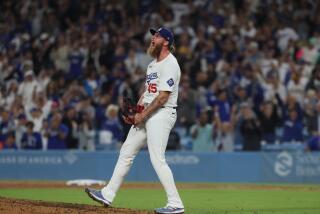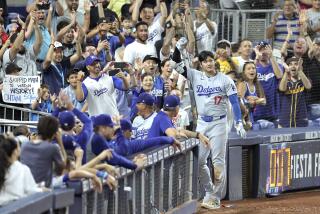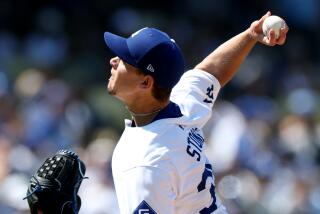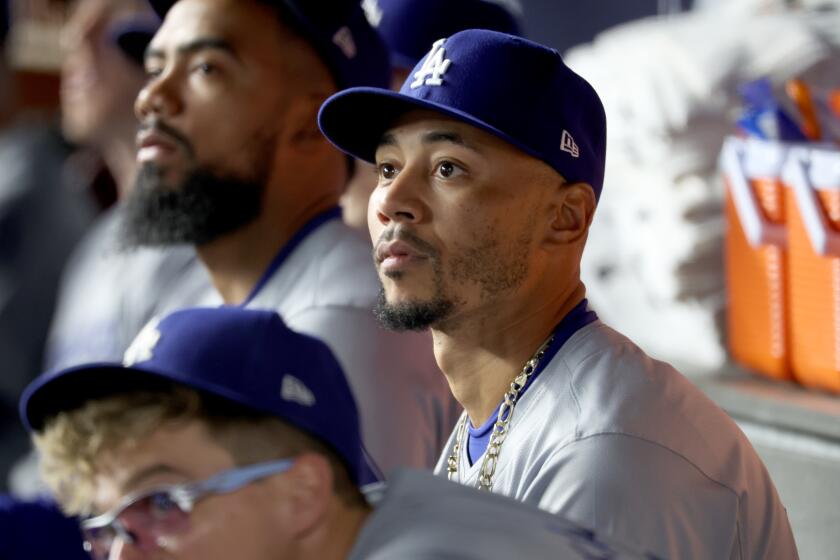Robert Van Scoyoc blazes trail to become Dodgers hitting coach
Reporting from Phoenix — The central tenet of Robert Van Scoyoc’s philosophy on hitting is void of any scary modern complicated analytics, gadgetry or vocabulary. The youngest hitting coach in the majors, Van Scoyoc is, by title, the head of the Dodgers’ hitting department, and he and his colleagues share an ideology that dates to a man named Ted Williams, circa 1940s: Hunt for pitches you can damage and keep your bat in the hitting zone as long as possible to damage them.
“It’s a fairly old-school philosophy,” Van Scoyoc said, “but I think it’s something that’ll be a principle as long as baseball exists.”
The difference is Van Scoyoc’s combination of backstory and teaching tactics clash with established thinking.
In an industry fighting itself to strike a balance between tradition and evolution, the Dodgers’ decision to hire Van Scoyoc in November, one that even Van Scoyoc acknowledged he never expected, drew attention for a few reasons. One, Van Scoyoc was 32 years old, younger than Justin Turner, the Dodgers’ most productive hitter, and he was replacing 53-year-old Turner Ward. Second, his unremarkable playing career ended after forgettable stints at two junior colleges. Third, he had never been a professional team’s hitting coach at any level; he was a consultant for the Dodgers for two years before serving as a hitting strategist for the Arizona Diamondbacks last season.
While front offices have been filled with people who have not played the game professionally, coaching staffs, for the most part, have remained reserved for those with traditional backgrounds, men who at least played the game for money before steadily rising in the coaching ranks. Van Scoyoc didn’t check those boxes. He defied convention.
Here’s how the Dodgers have responded to the doubts about Van Scoyoc: His lack of typical experience won’t prevent him from helping hitters succeed.
Examples of Van Scoyoc’s capabilities — most famously J.D. Martinez’s remarkable emergence with the Diamondbacks, Boston Red Sox and Detroit Tigers — already existed. There are others. Van Scoyoc is credited with helping the Dodgers’ Chris Taylor break out in 2017. Gavin Lux established himself as a top Dodgers prospect in 2018 after working with Van Scoyoc.
Last season, A.J. Pollock, then with the Diamondbacks, constantly sought Van Scoyoc’s help. The Dodgers center fielder would sometimes have Van Scoyoc over to his house for work in the cage before games and text Van Scoyoc for feedback when he wasn’t with the team on the road. He said he immediately bought in knowing Van Scoyoc’s history with Martinez, but also was impressed with his preparation, knowledge and awareness.
“I think as a player it’s tough when you see a guy that hasn’t played and you just kind of pay attention to their language and how they’re talking about stuff,” Pollock said. “When you talk with Robert, you realize right away he really understands the game. A guy could be talking mechanics all day but if he doesn’t have empathy and can’t put himself in the box and kind of the mindset of a player facing an elite arm, the emotions that come up, if you can’t do that, I feel like it’s going to be tough to relate to. But I think Robert does a really great job of doing that.”
The Dodgers, pushing boundaries on multiple fronts for decades, decided Van Scoyoc was the logical next addition in their pursuit to counter the drastic progression on the pitching side over the past decade, which has produced more strikeouts and fewer hits across the sport each season. The separation peaked in 2018, when major leaguers collectively batted .248, the lowest average since 1972, and again set a record with 41,207 strikeouts.
On a team level, the Dodgers offense was a powerful but maddeningly inconsistent machine. On the one hand, they led the National League in home runs and runs scored. On the other, they were one of the least clutch units in recent history, failing in high-leverage situations to a perplexing degree. The struggles have continued in the postseason and peaked in the World Series against elite pitching the past two years..
“We’re trying to avoid games in which we score zero, one, or two runs,” Friedman said. “Scoring three or more as consistently as we can should put us in position to win a lot of games. What we’re striving for is to individualize our offensive approach and put our guys in the best position to succeed.”
Van Scoyoc’s arrival did not radically alter how the Dodgers approach hitting. The team already employed Brant Brown, a former big leaguer who joined the Dodgers last season as an assistant hitting coach and minor league hitting coordinator, and ran in the same hitting circles as Van Scoyoc since Van Scoyoc was in high school. This offseason, Brown’s title became hitting strategist. He and Van Scoyoc are, in practice, co-heads of the hitting department, collaborating with assistant hitting coach Aaron Bates.
“The main objective is for us to be Batman and Batman,” Brown said.
That, in a way, makes Craig Wallenbrock their Alfred.
*****
To understand the Dodgers hitting department’s principles and goals, one must understand Wallenbrock, a hitting consultant for the club since 2015 who had three former students — Van Scoyoc, Johnny Washington (San Diego Padres), and Tim Laker (Seattle Mariners) — become hitting coaches this offseason.
Wallenbrock was an ordinary baseball player in his day, a reality he discovered in his several months at San Diego State after playing at Pasadena City College in the late 1960s. His value to the team, he realized, was dissecting teammates’ swings during practice. They recognized he possessed an eye for subtleties in mechanics and would ask for his opinion on their swings.
“I was there more for my batting practice than my actual skills helping a team,” Wallenbrock said. “But that was OK because that made me start looking at hitters and seeing things. I would just pick up things.”
He ditched the sport, frustrated thinking he didn’t have a future in it, to become a “hippy, borderline surfer” until the mid-1970s when his brother, 11 years his junior, asked for hitting help in high school. Wallenbrock threw him batting practice and, hunting for some context to improve his feedback, added another layer: He bought tapes of elite hitters and compared his brother’s mechanics to theirs. The work sparked a career. He eventually returned to his junior college to help as a coach, juggling a full-time sales job, before working for a few big league organizations and an agent, always throwing batting practice to players, filming it, and breaking it down for them. His clientele expanded enough for him to make a living as a private instructor.
“I would just say that I’ve really just kind of studied more than a lot of people who’ve just accepted traditional views as opposed to really getting in there and trying to break down every little fine detail,” Wallenbrock said. “I think that’s more or less what I do and I think that’s why they like it. They don’t have to accept everything. They just want to see those extra pairs of eyes that maybe see something that they don’t.”
Three decades after helping his brother, another high schooler approached asking for his assistance: Van Scoyoc. Wallenbrock was working at a private facility called The Ball Yard in Chatsworth alongside other hitting instructors, including Doug Latta, who is credited with helping Justin Turner become a premier bat since joining the Dodgers, and Brown, who worked with Wallenbrock during his playing career, which ended in 2000 after five years in the majors.
“We were doing this in 1998,” Brown said. “We would take video of batting practice and look at it on a VCR and a TV in a toolshed and we talked about things. It wasn’t what we talk about now, but we started to talk about way back then.”
Van Scoyoc took lessons with the group while in high school in Santa Clarita and continued through his brief college playing days. When those were over, he volunteered to work at the facility as Wallenbrock’s understudy.
“He came in with a passion for hitting and somebody who was very detailed,” said Tim Painton, Van Scoyoc’s coach for a season at Bakersfield College. “He obsessed over the mechanical parts of the swing and was somebody who was, quite honestly, a perfectionist.”
It was around then that Wallenbrock, whose clientele included Chase Utley and Ryan Braun, fostered the connection that culminated in the Dodgers hiring Van Scoyoc. Gabe Kapler was looking to make a comeback at age 32 after retiring to manage a single-A team for the 2007 season. He had worked with Wallenbrock when he first signed as a professional, but vanished until he returned that offseason admitting he’d half-listened to Wallenbrock in their previous stint together. Wallenbrock told him he didn’t change and adapt properly to sustain success. He implemented some adjustments and, after a winter together, Kapler batted .301 with an .838 on-base-plus-slugging percentage in 96 games with the Milwaukee Brewers.
In 2015, Kapler became the Dodgers’ farm director and vouched for the team to hire Wallenbrock and Van Scoyoc as hitting consultants. By then, Van Scoyoc’s work was producing results in the form of J.D. Martinez.
Martinez’s career was sputtering after the 2013 season. The Houston Astros had released him after he batted .251 with a .687 OPS in nearly 1,000 plate appearances in three seasons. There was no room in baseball for a below-average defensive corner outfielder with that offensive production. Martinez was tipped off to Wallenbrock by Jason Castro, a teammate with the Astros, and began working with him that offseason. But Wallenbrock realized he and Martinez wouldn’t make the best partnership.
Martinez wanted Wallenbrock to fly out to see him regularly and hip-replacement surgery rendered that a challenge. So Wallenbrock assigned Van Scoyoc to Martinez. He became Martinez’s personal coach and Martinez batted .315 with 23 home runs and a .912 OPS in 123 games the next season for the Detroit Tigers. Wallenbrock theorized the experience working in a big league environment helped develop Van Scoyoc as a coach.
“Look, J.D.’s success and my success have been tied because we’re very close,” Van Scoyoc said. “We’re still really good friends. I think he looks at it the same way but I think we look at it like we came up together. He was sort of on his way out of baseball and we just grew together. I think our success has been tied because we put in so much time together.”
To help revamp Martinez’s career, Van Scoyoc adopted Wallenbrock’s methods, obsessing over video and using it to implement modifications to better resemble the game’s best hitters. Then he began using the analytics increasingly available as the sport dove headfirst into the information age. He learned how to utilize the data to pinpoint and fix holes.
“He’s basically,” Wallenbrock said, “a double-edged sword.”
*****
Wallenbrock wants to make one thing clear: Contrary to popular belief, he isn’t the first person to suggest hitting the ball in the air is better than putting it on the ground. The idea, and the launch-angle phenomenon that has disseminated through baseball over the last half-decade, he said, can also be traced to that guy named Ted Williams.
“If you want to go back, in 1946, Ted Williams started talking about the upper-cut swing,” Wallenbrock said. “That was the year I was born so I had nothing to do with that.”
Van Scoyoc describes launch angle as an objective measurement, a piece of information that imparts something about the hitter. It’s not the end all, be all. If used the right way, it can help. Go about it wrong and the effects are pernicious. It just so happens that the chances of reaching base and inflicting damage are higher elevating the ball in the air than hitting it on the ground, especially since playing surfaces and glove technology have radically improved over the decades to make groundballs easier to field.
The aim, however, isn’t to hit every ball in the air; it’s to have every hitter maximize his efficiency in order to get on plane with the ball as quickly as possible. The earlier a hitter gets on plane with the pitch, the more time he has to adjust to its movement and velocity.
The implementation process begins with concocting an individual plan for each player. There isn’t a one-size-fits-all approach. The player’s levers and body — his foot size, his hand size, his arm length, etc. — are taken into account and drills are created to strengthen specific weaknesses for specific players.
“Think of it like ounces of soda,” Wallenbrock said. “If you’re an eight-ounce cup, you’re not going to be able to get more than eight ounces in it. But if you’re a 16-ounce cup and you only have four ounces in you, there’s a lot of room of improvement if we can figure out what’s preventing you from filling your cup fully.”
Before working alongside Brown and the rest of the hitting department with a group of players that included Enrique Hernandez, Cody Bellinger, Austin Barnes, and Justin Turner at Dodger Stadium this winter, Van Scoyoc said he pored over video when he got the job, spending an hour or two per player to become familiar with everyone on the roster. He watched clips when they were good and when they were bad. He noted the pitches they struggled against and tried to understand why.
“I obviously worked with Brownie a lot last year so I established a base, a guideline of what we were going to get into even though we didn’t know Rob was going to be our hitting coach this year,” Hernandez said. “I guess it made things easier because when you’ve got four eyes and four hands on you, it’s a lot easier to fix something in a quicker way and try to find a simple way to put it all together so it sustains for a longer period of time.”
This spring, cameras have been stationed in the batting cages at Camelback Ranch to tape batting practice sessions. Sometimes the video is used between rounds to spot problems and incorporate fixes in the next round. In addition to video, some players have taken batting practice with motion-capture technology monitoring every movement, unlocking another trove of information. Veteran outfielder Paulo Orlando, a Dodgers non-roster invitee, said he found out he was opening up his front side too soon after a session. Catcher Russell Martin, a 13-year veteran, said he noticed leaks in his mechanics for the first time.
“It’s the evolution of the game,” Martin said. “It’s physics. It’s not about somebody’s opinion. It’s there. The evidence is on the video.”
Martin has been one of the hitting department’s focuses this spring. The 36-year-old is coming off his worst offensive season and a high groundball rate has been identified as a reason. He’s worked with Van Scoyoc, Brown and Bates extensively to revamp his swing, which, he said, will take time to master. Martin explained that his new swing covers more pitches and areas than his old one, but the previous swing covered others. As a result, he must adjust what he’s hunting for.
“You keep working at it until it becomes almost second nature, where I’m hitting and I’m not even thinking about it,” Martin said. “You have to pattern that in. It takes reps. And once you reach a certain amount of reps, it just shows up and that’s when the magic happens.”
It’s easier to make magic with a naturally gifted hitter, with the Miguel Cabreras and Mike Trouts of the world. Those are the models Wallenbrock and his disciples have studied. Wallenbrock said he examines the top five percent of hitters in the game by five-year periods because, he thinks, the game changes every five years. He inspects commonalities and that becomes the prototype for his pupils. So, what is the prototype for this period?
“That’s something I would rather not talk about openly,” Wallenbrock said, “because I’d like to think the Dodgers are a little ahead on that and would not like to have it out there.”
If the Dodgers hold an edge, it’s on Van Scoyoc, Brown, and company to best position hitters to capitalize. Do that and help the Dodgers win their first World Series in 30 years, and any gripes over methods and backgrounds are disregarded.
“My goal,” Van Scoyoc said, “is to help them become the most complete hitter possible.”
Sign up for our Dodgers newsletter »
Twitter: @jorgecastillo
More to Read
Are you a true-blue fan?
Get our Dodgers Dugout newsletter for insights, news and much more.
You may occasionally receive promotional content from the Los Angeles Times.











